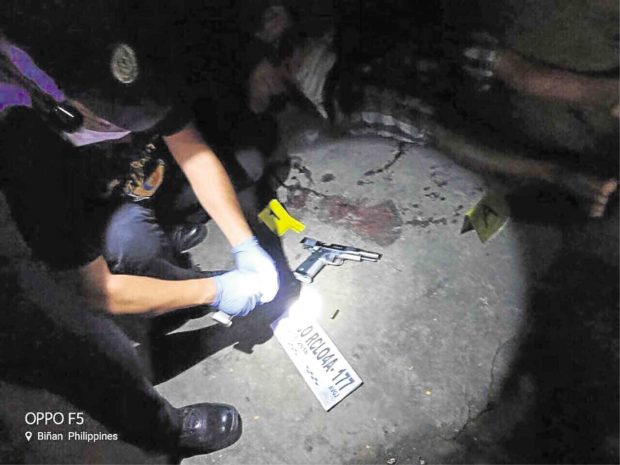CHR looks into drug deaths in Calabarzon

SHOOTOUT A gun is recovered at the spot where drug suspect Rolando Bugarin died after a shootout with policemen in Biñan City, Laguna province, in July. —PHOTO COURTESY OF CALABARZON PNP
LUCENA CITY—At least 97 percent of 183 drug-related deaths being investigated by the Commission on Human Rights (CHR) in Calabarzon (Cavite, Laguna, Batangas, Rizal and Quezon) happened in police operations in the region since January, a CHR official said.
Records sent by lawyer Rexford Guevarra, CHR regional director, on Wednesday showed that from January to Nov. 15, 178 cases were reported during antidrug operations conducted by policemen. Suspects in the remaining cases were unidentified, records showed.
“The number of drug-related killings this year [increased by] more than 300 percent … compared to last year’s figure,” Guevarra said in a telephone interview.
In 2016, only 24 drug-related killings during police operations were reported in the region. This jumped to 57 deaths the following year.
Guevarra said most of the victims resisted arrest and engaged policemen in shootouts.
Article continues after this advertisementLaguna posted the highest number of drug-related killings with 60 cases followed by Cavite with 51. Batangas had 32 while Rizal and Quezon had 20 each.
Article continues after this advertisementFormal complaint
Supt. Chitadel Gaoiran, spokesperson for the Calabarzon police, said all cases were presumed to be “legitimate police operations.”
“If there is any formal complaint, the regional office is open to any investigation,” she said in a telephone interview on Wednesday.
Gaoiran said the Philippine National Police had several avenues, for instance through its Internal Affairs Services, to investigate suspected extrajudicial killings where policemen were allegedly involved.
In an earlier interview, Supt. Reydante Ariza, Lucena City police chief, dismissed accusations of wrongdoing against local policemen.
Ariza stood by their reports and the legitimacy of their drug operations.
He said they were ready to face all investigations to clear their names.
Summary execution
Guevarra said the total number of drug-related killings and suspected summary executions perpetrated by policemen could be more than what their data showed.
He said their records were based on information provided by complainants seeking their office’s help and those reported by the media.
“We’re facing challenges in our investigation because the police were not giving us their official reports. So, how can we determine if it’s really ‘nanlaban’ (a slain suspect resisting arrest) or not?” he said.
More deaths
In Quezon province, suspected drug pushers, Christopher Supremo and Hilario Torres, were killed in a drug bust at Barangay Market View in Lucena City on Tuesday.
Ariza said Torres, when he sensed that he was dealing with undercover policemen, drew his .38-caliber revolver but it jammed when he tried to shoot a policeman. Supremo also drew his .45-caliber pistol and shot the policeman but missed.
Another policeman fired at the suspects, killing them instantly.
On Sunday night, suspected drug pusher Rhoderick Hugo was killed in another antidrug operation at Barangay 5, also in Lucena, when he resisted arrest.
But one of Hugo’s relatives dismissed the police’s version of the operation.
The relative said Hugo was kneeling, with his hands on his head, and was pleading for his life before he was shot.
“But the armed man in civilian clothes still shot and killed him,” the relative said.
A neighbor and the victim’s relative admitted that Hugo was a drug user and a “runner.”
“He was being asked by drug users to buy ‘shabu’ (crystal meth) for them in exchange for P50 or P100. But he was not the pusher,” the neighbor said.
The three latest victims brought to seven the total number of suspected drug pushers slain in police operations in Lucena City this month.
Lawyer Rodolfo Zabella Jr., president of Integrated Bar of the Philippines in Quezon province, said members of the group would meet this week to discuss ways to help the families of of those killed in the government’s drug war and find the truth about the killings. —With a report from Maricar Cinco